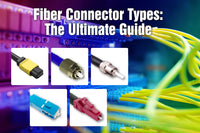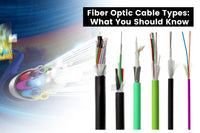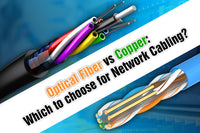An optical fiber is usually made of pure silica (glass) for its great internal refraction. These transparent fibers have been widely used for data transmission in telecommunication, the medical industry, decoration and lighting systems, and even the military and aerospace industry. There are mainly two types of optical fibers based on the propagation methods of light: single mode and multimode fiber. You may be confused about knowledge about single mode and multimode fibers. This article will focus on the difference between single-mode and multimode fiber.
Single Mode vs. Multimode Fiber
Before installing fiber optic cabling, it is important to understand the comparison of single mode and multimode fiber. And then you can decide whether to install single-mode or multimode optical fibers.
Single Mode Fiber
Single mode optical fiber (SMF) only carries a single mode of light. It usually features a core ranging from 8 μm to 10.5 μm, which is surrounded by a cladding and the overall diameter of the optical fiber can be 125 μm. Single mode fiber has less signal attenuation and narrow dispersion.
Multimode Fiber
Multimode fiber (MMF) usually features a relatively large core diameter of 50 μm or above that allows multi modes of light to pass through the core. Like single mode fiber, the multimode fiber is also surrounded by a cladding that makes the overall diameter of the optical fiber 125 μm. Multimode optical fibers are usually divided into five types: OM1, OM2, OM3, OM4, and OM5.

Difference Between Single Mode and Multimode Fiber
There is no way to distinguish single mode and multimode fiber with the naked eye, but in fact, there are many differences between them including construction, bandwidth, distance, and installation cost.
Differences in Construction
The most distinctive difference between the single mode and multimode optical fiber is the core diameter. Single mode fiber features a smaller core than multimode fiber. The typical diameter of single mode fiber is 9 μm, while that of multimode fiber is 50 µm and 62.5 µm. The smaller core diameter results in lower signal attenuation and longer transmission distance.

You can distinguish single mode fiber from multimode fiber by the jacket color. According to TIA-598C recommendation, the single model fiber is usually yellow and the multimode fiber is usually blue or orange. Some manufacturers may also use different colors.

Besides, the light source can also be a bit different. In general, the multimode fiber uses LED light source, while single mode fiber uses a laser or laser diode.
Difference in Bandwidth
In terms of bandwidth, single mode fiber is the winner. Single mode fiber only allows one light mode to travel through the core and supports powerful light source with low signal attenuation, so it can theoretically provide unlimited bandwidth. Multimode fiber bandwidth is limited by its multiple light modes with higher signal attenuation, so the bandwidth of multimode fiber is not good as single mode fiber.
Single Mode vs. Multimode Fiber Distance
Though the transmission distance of optical fiber can be affected by electronic devices and light output, single-mode fiber has a better performance than multimode fiber.
In multimode fiber, each light has its own path, and it will travel through the end of the fiber at different times, which results in modal dispersion. It will limit the bandwidth and distance. In general, the max distance that multimode fiber can transfer ranges from 300 meters to 500 meters (1,000 to 1,800 feet).
In single-mode fiber, the small core limits dispersion, and the high bandwidth can be transmitted to a longer distance. Because of that, single-mode fiber can be used to transmit data under the sea to connect global Internet. Single-mode fiber can support 1Gb Ethernet up to 5,000 meters.
Installation Cost
In the cabling system, you should consider the distance and the cost of the optical transceiver and optical fiber. In general, single-mode fiber costs less than multimode fiber, but the other parts of the fiber cabling can be more expensive than multimode fiber.
To take advantage of single-mode fiber’s features, it is often used in long-distance applications. So, it needs transceivers with lasers that increase the cost of installation. In general, single-mode transceivers are more expensive than multimode transceivers. In some large data centers, people tend to choose multimode solutions thanks to cost-saving transceivers and power. But in submarine communications, single-mode fibers are commonly used.
Final Thoughts: How to Choose?
Both single-mode fiber and multimode fiber give a high-speed and durable bandwidth installation, and knowing the difference between them can help you know more about fiber installation. In general, single mode fiber is more suitable for long-distance applications; while multimode fiber is greater for short-distance applications. Whether to choose a single mode or multimode fiber system depends on your own needs and budget. But remember, a multimode fiber system is still recommended for a data center of 500- to 600-meter distance. And single-mode fiber is the best choice for a distance up to thousands of meters.

FAQs
Single-mode fiber vs. multimode fiber: Which one is better?
You can see from the article that single-mode and multimode fiber have their own advantages and just choose the best one based on your own needs.
Will multimode fiber transceivers work on single-mode fiber?
This is not recommended. If you use a multimode fiber transceiver on single-mode fiber, a great optical loss may happen, which will affect the data transmission. However, under some conditions, single-mode fiber transceivers may work on multimode fiber.
Can I connect multimode fiber with single-mode fiber?
Multimode fiber and single-mode fiber have different core diameters, so remember not to connect multimode fiber with single-mode fiber or it may cause optical loss.
For more information on this topic, you can keep up on our blogs. While VCELINK offers general and basic information for our customers and other visitors to the website, it’s not professional advice.



Excellent, to the point, writing. Tight. Have you written anything the describes what is meant by mode?
The last table has just Single-mode fiber on the columns. I think the third column should be Multi-Mode fiber.